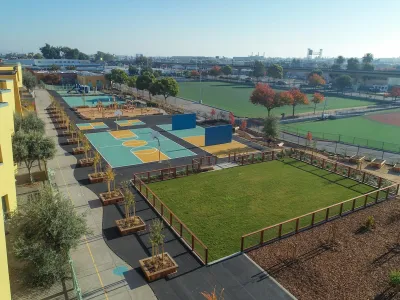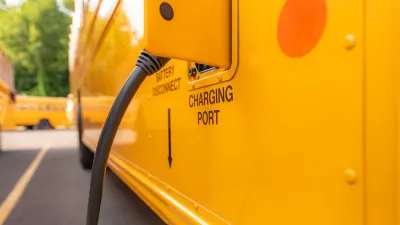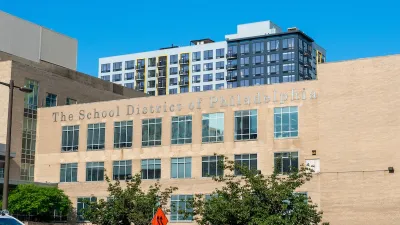With help from community partners like the Trust for Public Land, Oakland Unified School District is turning barren, asphalt-covered schoolyards into vibrant, green spaces that support outdoor learning, play, and student well-being.

Across the country, many K-12 schoolyards are dominated by heat-absorbing concrete, with little vegetation or opportunity for outdoor learning. In Oakland, California, the school district faced the same budget pressures as many others—prioritizing classroom upgrades, air quality improvements, and deferred maintenance over outdoor improvements. However, thanks to external partnerships like the one with the Trust for Public Land, the Oakland Unified School District has successfully begun transforming these concrete spaces into vibrant, green schoolyards.
With support from the Trust for Public Land, Oakland has completed 20 green schoolyard projects and planted nearly 475 trees, with plans to expand even further this year. Community engagement has been vital, with design input coming from students and the public — leading to creative, student-centered outdoor spaces. Though not every idea (like smoothie bars and water slides) made the cut, the collaboration created spaces that students are excited to use. In one instance, more than 200 volunteers completed a schoolyard transformation in just three days, demonstrating strong community investment.
The shift to greener schoolyards has brought numerous benefits beyond aesthetics. Students and staff enjoy cooler spaces, improved engagement, fewer disciplinary issues, and more opportunities for learning and recreation. Key features of these spaces include native gardens, stormwater capture systems, nature play zones, and outdoor classrooms. A central lesson from Oakland’s success is the importance of outside funding and civic-minded partners, proving that sustainable schoolyards are achievable when communities rally behind them.
FULL STORY: Green Schoolyards Help Accomplish Sustainability Goals

Alabama: Trump Terminates Settlements for Black Communities Harmed By Raw Sewage
Trump deemed the landmark civil rights agreement “illegal DEI and environmental justice policy.”

Planetizen Federal Action Tracker
A weekly monitor of how Trump’s orders and actions are impacting planners and planning in America.

The 120 Year Old Tiny Home Villages That Sheltered San Francisco’s Earthquake Refugees
More than a century ago, San Francisco mobilized to house thousands of residents displaced by the 1906 earthquake. Could their strategy offer a model for the present?

LA’s Tree Emergency Goes Beyond Vandalism
After a vandal destroyed dozens of downtown LA trees, Mayor Karen Bass vowed to replace them. Days later, she slashed the city’s tree budget.

Sacramento Leads Nation With Bus-Mounted Bike Lane Enforcement Cameras
The city is the first to use its bus-mounted traffic enforcement system to cite drivers who park or drive in bike lanes.

Seattle Voters Approve Social Housing Referendum
Voters approved a corporate tax to fund the city’s housing authority despite an opposition campaign funded by Amazon and Microsoft.
Urban Design for Planners 1: Software Tools
This six-course series explores essential urban design concepts using open source software and equips planners with the tools they need to participate fully in the urban design process.
Planning for Universal Design
Learn the tools for implementing Universal Design in planning regulations.
Ada County Highway District
Clanton & Associates, Inc.
Jessamine County Fiscal Court
Institute for Housing and Urban Development Studies (IHS)
City of Grandview
Harvard GSD Executive Education
Toledo-Lucas County Plan Commissions
Salt Lake City
NYU Wagner Graduate School of Public Service





























